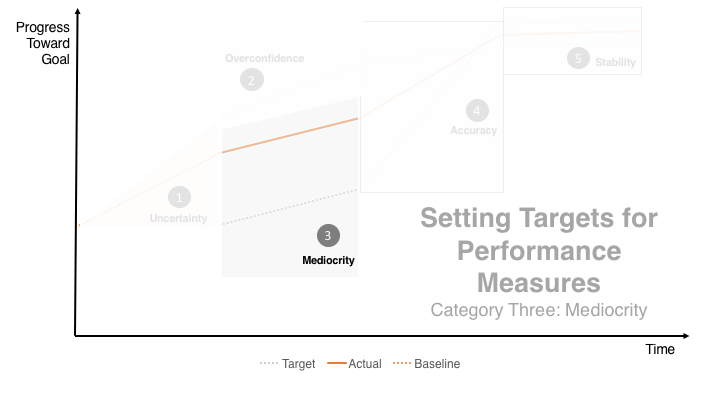Category Three: Mediocrity
Mediocrity occurs when an organization sets targets far below its proven capacity. This most commonly occurs when individuals and programs want to appear on target or above target at all times. This practice adds very little value to any organization and should be avoided.
Signs of mediocrity:
- Baseline data exists, but there is no evidence the existence of a target helps raise or lower performance.
- The measure and/or target is shared with the public and there is fear of public embarrassment.
- The target is not revised on predetermined intervals based on emerging data.
- The target is always set below past performance in order to continuously “succeed” (e.g., the performance dashboard or scorecard is “all green all the time”).
- Actual performance remains stagnant.
Figure 4

What to do with mediocrity?
- Understand it. Mediocre targets exist for three (often co-occurring) reasons: fear, distrust, and/or complacency. They can emanate from specific individuals, but they can also be endemic to an organization’s culture. Therefore, understanding and addressing the root cause of mediocrity is critical to overcoming it.
- Fear: Managers often fear losing funding, staff, or their own jobs if a target is not met; so they often set targets artificially low to ensure success.
- Distrust: Managers do not trust how journalists or the general public will interpret missed targets.
- Complacency: Managers sometime lack a desire to improve the target. They may see the effort as fixing something that is not broken. They may also be unaware of the program’s actual capacity because the data may not be accessible to them.
- Correct it. If fear, distrust, or complacency are limited to a small number of individuals, then overcoming mediocrity can be easy, because data to show them a better way forward is available. For the average program manager, there are four quick things to make the case for a more reasonable target that drives performance improvement without scaring them away:
- Plan for future success by providing resources to help set a reasonable target next time.
- Prevent it from recurring. If fear, distrust, or complacency are endemic to an organization’s culture, preventing it from recurring is critical. Leaders should message the importance of continuously improving services by striving for what is possible. Missing a target is less problematic than failing to try.
- A culture of fear and/or distrust will not be helped by creating a culture of accountability; so leaders should raise expectations through more inclusive and supportive language (e.g., let us figure this out together, us against the problem).
- A culture of complacency needs a shot in the arm from senior leadership; stronger senior leadership directives, where leaders reject mediocrity and embrace accountability, may work better in those circumstances.
What not to do with mediocrity?
- Do not tolerate it. There should be no dashboard, PowerPoint slide, or scorecard where every measure is green because the targets have been met. If leaders tolerate the presentation of mediocre targets, then they are inherently blessing their proliferation.
- Do not exacerbate it. Since mediocre targets often emanate from fear and distrust, shaming people out of the practice with talk of increased “accountability” can have an exacerbating, not an ameliorating effect. Consider using more inclusive and empowering language to drive up performance expectations.